
History of the tank
Encyclopedia
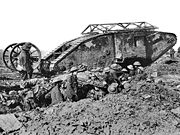
Tank
A tank is a tracked, armoured fighting vehicle designed for front-line combat which combines operational mobility, tactical offensive, and defensive capabilities...
began in World War I
World War I
World War I , which was predominantly called the World War or the Great War from its occurrence until 1939, and the First World War or World War I thereafter, was a major war centred in Europe that began on 28 July 1914 and lasted until 11 November 1918...
, when armoured all-terrain fighting vehicles were first deployed as a response to the problems of trench warfare
Trench warfare
Trench warfare is a form of occupied fighting lines, consisting largely of trenches, in which troops are largely immune to the enemy's small arms fire and are substantially sheltered from artillery...
, ushering in a new era of mechanized warfare
Mechanized Warfare
Mechanized Warfare is the sixth studio album released by American power metal band Jag Panzer, released in 2001. This album is more progressive than the band's previous work...
. Though initially crude and unreliable, tanks eventually became a mainstay of ground armies. By World War II
World War II
World War II, or the Second World War , was a global conflict lasting from 1939 to 1945, involving most of the world's nations—including all of the great powers—eventually forming two opposing military alliances: the Allies and the Axis...
, tank design had advanced significantly, and tanks were used in quantity in all land theatres of the war. The Cold War
Cold War
The Cold War was the continuing state from roughly 1946 to 1991 of political conflict, military tension, proxy wars, and economic competition between the Communist World—primarily the Soviet Union and its satellite states and allies—and the powers of the Western world, primarily the United States...
saw the rise of modern tank doctrine and the rise of the general-purpose main battle tank
Main battle tank
A main battle tank , also known as a battle tank or universal tank, is a tank that fills the heavy direct fire role of many modern armies. They were originally conceived to replace the light, medium, heavy and super-heavy tanks. Development was spurred onwards in the Cold War with the development...
. The tank still provides the backbone to land combat operations in the 21st century.
Development
World War I generated new demands for strongly armoured self-propelled weapons which could navigate any kind of terrain, leading to the development of the tank. The great weakness of the tank's predecessor, the armoured car, was that it required smooth terrain to move upon, and new developments were needed for cross-country capability.The tank was originally designed as a special weapon to solve an unusual tactical situation: the stalemate
Stalemate
Stalemate is a situation in chess where the player whose turn it is to move is not in check but has no legal moves. A stalemate ends the game in a draw. Stalemate is covered in the rules of chess....
of the trenches on the Western Front
Western Front
Western Front was a term used during the First and Second World Wars to describe the contested armed frontier between lands controlled by Germany to the east and the Allies to the west...
. "It was a weapon designed for one simple task: crossing the killing zone
No Man's Land
No man's land is an unoccupied area between two opposing positions.No Man's Land may also refer to:-Places:In the United Kingdom* No Man's Land, Cornwall, England* No Man's Land Fort, off the coast of England* Nomansland, Devon, England...
between trench lines and breaking into enemy defenses." The armoured tank was intended to be able to survive artillery
Artillery
Originally applied to any group of infantry primarily armed with projectile weapons, artillery has over time become limited in meaning to refer only to those engines of war that operate by projection of munitions far beyond the range of effect of personal weapons...
bombardments and machine-gun fire, and pass through barbed wire
Barbed wire
Barbed wire, also known as barb wire , is a type of fencing wire constructed with sharp edges or points arranged at intervals along the strand. It is used to construct inexpensive fences and is used atop walls surrounding secured property...
in a way infantry units could not hope to, thus allowing the stalemate to be broken.
Few recognized during World War I that the means for returning mobility and shock action to combat was already present in a device destined to revolutionize warfare on the ground and in the air. This was the internal combustion engine
Internal combustion engine
The internal combustion engine is an engine in which the combustion of a fuel occurs with an oxidizer in a combustion chamber. In an internal combustion engine, the expansion of the high-temperature and high -pressure gases produced by combustion apply direct force to some component of the engine...
, which had made possible the development of the tank and eventually would lead to the mechanized forces that were to assume the old roles of horse cavalry
Cavalry
Cavalry or horsemen were soldiers or warriors who fought mounted on horseback. Cavalry were historically the third oldest and the most mobile of the combat arms...
and to loosen the grip of the machine-gun on the battlefield. With increased firepower and protection, these mechanized forces would, only some 20 years later, become the armour of World War II. When self-propelled artillery
Self-propelled artillery
Self-propelled artillery vehicles are combat vehicles armed with artillery. Within the term are covered self-propelled guns and rocket artillery...
, the armoured personnel carrier
Armoured personnel carrier
An armoured personnel carrier is an armoured fighting vehicle designed to transport infantry to the battlefield.APCs are usually armed with only a machine gun although variants carry recoilless rifles, anti-tank guided missiles , or mortars...
, the wheeled cargo vehicle, and supporting aviation
Aviation
Aviation is the design, development, production, operation, and use of aircraft, especially heavier-than-air aircraft. Aviation is derived from avis, the Latin word for bird.-History:...
—all with adequate communications—were combined to constitute the modern armored division, commanders regained the capability of maneuver.
Numerous concepts of armoured all-terrain vehicles had been imagined for a long time. With advent of trench warfare
Trench warfare
Trench warfare is a form of occupied fighting lines, consisting largely of trenches, in which troops are largely immune to the enemy's small arms fire and are substantially sheltered from artillery...
in World War I
World War I
World War I , which was predominantly called the World War or the Great War from its occurrence until 1939, and the First World War or World War I thereafter, was a major war centred in Europe that began on 28 July 1914 and lasted until 11 November 1918...
, the Allied
Allies of World War I
The Entente Powers were the countries at war with the Central Powers during World War I. The members of the Triple Entente were the United Kingdom, France, and the Russian Empire; Italy entered the war on their side in 1915...
French
France
The French Republic , The French Republic , The French Republic , (commonly known as France , is a unitary semi-presidential republic in Western Europe with several overseas territories and islands located on other continents and in the Indian, Pacific, and Atlantic oceans. Metropolitan France...
and British
United Kingdom
The United Kingdom of Great Britain and Northern IrelandIn the United Kingdom and Dependencies, other languages have been officially recognised as legitimate autochthonous languages under the European Charter for Regional or Minority Languages...
developments of the tank were largely parallel and coincided in time.
Early concepts
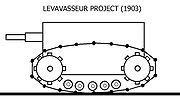
Levavasseur project
The Levavasseur project was an early project for a tank designed in 1903 by the French Captain Levavasseur of the 6th Artillery Battalion, described as a "automobile canon project" . It is considered as the first description, made by a soldier, of what was going to become the tank...
, a canon autopropulseur (self-propelled cannon), moved by a caterpillar system and fully armoured for protection. Powered by a 80 hp petrol engine, "the Levavasseur machine would have had a crew of three, storage for ammunition, and a cross-country ability", but the viability of the project was disputed by the Artillery Technical Committee, until it was formally abandoned in 1908 when it was known that a caterpillar tractor had been developed, the Hornsby
Richard Hornsby & Sons
Richard Hornsby & Sons was an engine and machinery manufacturer in Lincolnshire, England from 1828 until 1918. The company was a pioneer in the manufacture of the oil engine developed by Herbert Akroyd Stuart and marketed under the Hornsby-Akroyd name. The company developed an early track system...
of engineer David Roberts
David Roberts (engineer)
David Roberts was the Chief Engineer and managing director of Richard Hornsby & Sons in the early 1900s...
.

H. G. Wells
Herbert George Wells was an English author, now best known for his work in the science fiction genre. He was also a prolific writer in many other genres, including contemporary novels, history, politics and social commentary, even writing text books and rules for war games...
, in his short story The Land Ironclads
The Land Ironclads
Written by H. G. Wells, "The Land Ironclads" is a short story that originally appeared in the December 1903 issue of the Strand Magazine and set in a war similar to the First World War...
, published in The Strand Magazine in December 1903, had described the use of large, armoured cross-country vehicles, armed with cannon and machine-guns, and equipped with pedrail wheels (an invention which he acknowledged as the source for his inspiration), to break through a system of fortified trenches, disrupting the defense and clearing the way for an infantry advance:
Some eight years later, in 1911, two practical tank designs were developed independently by the Austrian
Austrians
Austrians are a nation and ethnic group, consisting of the population of the Republic of Austria and its historical predecessor states who share a common Austrian culture and Austrian descent....
engineering officer Günther Burstyn
Günther Burstyn
Gunther Burstyn was an inventor, technician, and officer of the Austro-Hungarian Army....
and Australian civil engineer Lancelot de Mole
Lancelot De Mole
Lancelot Eldin De Mole CBE, was an Australian engineer and inventor. He suggested the idea of what would become the tank to the British authorities before the First World War but his idea was not taken up at the time and the tank was brought to fruition later by others.-Life:De Mole was born in...
, but both were rejected by governmental administrations.
American tracked tractors
Benjamin HoltBenjamin Holt
Benjamin Leroy Holt was an American inventor who was the first to patent and manufacture a first practical crawler-type tread tractor. The continuous-type track is used for heavy agricultural and engineering vehicles to spread the weight over a large area to prevent the vehicle from sinking into...
of the Holt Manufacturing Company
Holt Manufacturing Company
The Holt Manufacturing Company traces its roots to the 1883 establishment of Stockton Wheel Service in Stockton, California, United States. Benjamin Holt, who was later credited with patenting the first workable crawler tractor design, incorporated the Holt Manufacturing Company in 1892...
of Stockton, California
Stockton, California
Stockton, California, the seat of San Joaquin County, is the fourth-largest city in the Central Valley of the U.S. state of California. With a population of 291,707 at the 2010 census, Stockton ranks as this state's 13th largest city...
was the first to patent a workable crawler type tractor in 1907. The center of such innovation was in England, and in 1903 he traveled to England to learn more about ongoing development, though all those he saw failed their field tests. Holt paid Alvin Lombard for the right to produce vehicles under Lombard's patent for the Lombard Steam Log Hauler
Lombard Steam Log Hauler
The Lombard Steam Log Hauler, patented 29 May 1901, was the first successful commercial application of a continuous track for vehicle propulsion. The concept was later used for military tanks during World War I and for agricultural tractors and construction equipment following the...
.
Holt returned to Stockton and, utilizing his knowledge and his company's metallurgical
Metallurgy
Metallurgy is a domain of materials science that studies the physical and chemical behavior of metallic elements, their intermetallic compounds, and their mixtures, which are called alloys. It is also the technology of metals: the way in which science is applied to their practical use...
capabilities, he became the first to design and manufacture practical continuous tracks for use in tractors. In England, David Roberts of Hornsby & Sons, Grantham
Grantham
Grantham is a market town within the South Kesteven district of Lincolnshire, England. It bestrides the East Coast Main Line railway , the historic A1 main north-south road, and the River Witham. Grantham is located approximately south of the city of Lincoln, and approximately east of Nottingham...
, obtained a patent for a design in July 1904, In the United States, Holt replaced the wheels on a 40 hp Holt steamer, No. 77, with a set of wooden tracks bolted to chains. On November 24, 1904, he successfully tested the updated machine plowing the soggy delta land of Roberts Island.
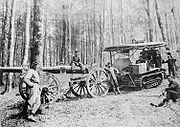
World War I
World War I , which was predominantly called the World War or the Great War from its occurrence until 1939, and the First World War or World War I thereafter, was a major war centred in Europe that began on 28 July 1914 and lasted until 11 November 1918...
broke out, with the problem of trench warfare
Trench warfare
Trench warfare is a form of occupied fighting lines, consisting largely of trenches, in which troops are largely immune to the enemy's small arms fire and are substantially sheltered from artillery...
and the difficulty of transporting supplies to the front, the pulling power of crawling-type tractors drew the attention of the military. Holt tractors were used to replace horses to haul artillery and other supplies. The Quartermaster Corps also used them to haul long trains of freight wagons over the unimproved dirt tracks behind the front. Holt tractors were, ultimately, the inspiration for the development of the British and French tanks. By 1916, about 1000 of Holt's Caterpillar tractors were used by the British in World War I
World War I
World War I , which was predominantly called the World War or the Great War from its occurrence until 1939, and the First World War or World War I thereafter, was a major war centred in Europe that began on 28 July 1914 and lasted until 11 November 1918...
. Holt vice president Murray M. Baker
Murray M. Baker
Murray Morrison Baker was the first executive vice president of Holt Manufacturing Company that became Caterpillar Tractor Company....
said that these tractors weighed about 18000 lbs and had 120 hp. By the end of the war, 10,000 Holt vehicles had been used in the Allied war effort.
Fully tracked caterpillar tractors became commercially available in 1908, especially in the United States
United States
The United States of America is a federal constitutional republic comprising fifty states and a federal district...
, but also in lesser quantities in Europe, and were to prove a solution to the cross-country requirements of World War I battlefields. Over the next four years, they became a major artillery tractor
Artillery tractor
Artillery tractor is a kind of tractor, also referred to as a gun tractor, a vehicle used to tow artillery pieces of varying weights.-Traction:...
, mainly used to haul medium guns like the 6-inch howitzer, the 60-pounder, and later the 9.2-inch
BL 9.2 inch Howitzer
The Ordnance BL 9.2 inch howitzer was the principal counter-battery equipment of British forces in France in World War I. It equipped a substantial number of siege batteries of the Royal Garrison Artillery...
howitzer.
By 1916, about 1,000 of Holt's Caterpillar tractors were in use by the British on the Western Front
Western Front
Western Front was a term used during the First and Second World Wars to describe the contested armed frontier between lands controlled by Germany to the east and the Allies to the west...
. By the end of World War I, the British War Office had received 2,100 Holt tractors, about 1,800 of the Holt Model 45 "Caterpillars"; 1,500 of the Holt Model 75 "Caterpillars", and 90 of the Holt six-cylinder Model 120 "Caterpillars", about one-eighth of approximately 5,000 Holt vehicles used by all Allied forces. Holt tractors built under license in Austria and obtained by the Germans
Germans
The Germans are a Germanic ethnic group native to Central Europe. The English term Germans has referred to the German-speaking population of the Holy Roman Empire since the Late Middle Ages....
formed the basis of the German A7V tank
A7V
The A7V was a tank introduced by Germany in 1918, near the end of World War I. One hundred vehicles were ordered during the spring of 1918, but only 21 were delivered. It was nicknamed "The Moving Fortress" by the British because of the shape of the hull...
and were also the inspiration behind Renault tanks
Renault FT-17
The Renault FT, frequently referred to in post-WWI literature as the "FT-17" or "FT17" , was a French light tank; it is among the most revolutionary and influential tank designs in history...
.
French development
The French put the Holt tractor to use in the French ArmyFrench Army
The French Army, officially the Armée de Terre , is the land-based and largest component of the French Armed Forces.As of 2010, the army employs 123,100 regulars, 18,350 part-time reservists and 7,700 Legionnaires. All soldiers are professionals, following the suspension of conscription, voted in...
soon after the beginning of World War I to pull heavy artillery pieces in difficult terrain. The French colonel Jean Baptiste Estienne
Jean-Baptiste Eugène Estienne
Jean Baptiste Eugène EstienneEstienne's forenames are frequently incorrectly given as Jean-Baptiste Eugène. He was christened with the three names Jean, Baptiste, and Eugène, but disliked the name Baptiste, and preferred to be addressed as Eugène. He usually signed himself J.E. Estienne. See...
articulated the vision of a cross-country armoured vehicle on 24 August 1914:
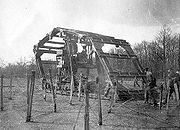
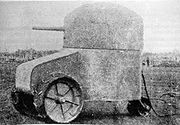

Boirault machine
The Boirault machine , was an early French experimental landship, designed in 1914 and built in early 1915. It has been considered as "another interesting ancestor of the tank",...
, with the objective of flattening barbed wire
Barbed wire
Barbed wire, also known as barb wire , is a type of fencing wire constructed with sharp edges or points arranged at intervals along the strand. It is used to construct inexpensive fences and is used atop walls surrounding secured property...
defences and riding over gaps in a battlefield. The machine was made of huge parallel tracks, formed by 4x3 meter metallic frames, rotating around a triangular motorized center. This device proved too fragile and slow, as well as incapable of changing direction easily, and was abandoned.

Canal
Canals are man-made channels for water. There are two types of canal:#Waterways: navigable transportation canals used for carrying ships and boats shipping goods and conveying people, further subdivided into two kinds:...
construction at the Compagnie Nationale du Nord, proposed to the French Ministry a design for a "landship" with armour and armament based on the motorization of a compactor
Compactor
A compactor is a machine or mechanism used to reduce the size of waste material or soil through compaction. A trash compactor is often used by homes and businesses to reduce the volume of trash....
with heavy wheels or rollers. The Frot-Laffly was tested on 18 March 1915, and effectively destroyed barbed wire
Barbed wire
Barbed wire, also known as barb wire , is a type of fencing wire constructed with sharp edges or points arranged at intervals along the strand. It is used to construct inexpensive fences and is used atop walls surrounding secured property...
lines, but was deemed lacking in mobility. The project was abandoned in favour of General Estienne's development using a tractor base, codenamed "Tracteur Estienne".
In 1915, attempts were also made to develop vehicles with powerful armour and armament, mounted on the cross-country chassis
Chassis
A chassis consists of an internal framework that supports a man-made object. It is analogous to an animal's skeleton. An example of a chassis is the underpart of a motor vehicle, consisting of the frame with the wheels and machinery.- Vehicles :In the case of vehicles, the term chassis means the...
of agricultural tractors, with large dented wheels, such as the Aubriot-Gabet "Fortress" (Fortin Aubriot-Gabet). The vehicle was powered by electricity (complete with a supply cable), and armed with a Navy cannon of 37mm, but it too proved impractical.
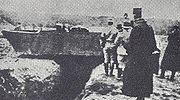

Schneider Electric
Schneider Electric is a French global company. It was founded in 1836 by two brothers, Eugène and Adolphe Schneider.In the first part of the 20th century, Schneider et Cie associated itself with Westinghouse Systems, a major international electrical group at the time. The group began manufacturing...
sent out its chief designer, Eugène Brillié, to investigate tracked tractors from the American Holt Manufacturing Company
Holt Manufacturing Company
The Holt Manufacturing Company traces its roots to the 1883 establishment of Stockton Wheel Service in Stockton, California, United States. Benjamin Holt, who was later credited with patenting the first workable crawler tractor design, incorporated the Holt Manufacturing Company in 1892...
, at that time participating in a test programme in England
England
England is a country that is part of the United Kingdom. It shares land borders with Scotland to the north and Wales to the west; the Irish Sea is to the north west, the Celtic Sea to the south west, with the North Sea to the east and the English Channel to the south separating it from continental...
, for a project of mechanical wire-cutting machines. On his return Brillié, who had earlier been involved in designing armoured cars for Spain
Spain
Spain , officially the Kingdom of Spain languages]] under the European Charter for Regional or Minority Languages. In each of these, Spain's official name is as follows:;;;;;;), is a country and member state of the European Union located in southwestern Europe on the Iberian Peninsula...
, convinced the company management to initiate studies on the development of a Tracteur blindé et armé (armoured and armed tractor), based on the Baby Holt
Holt tractor
The Holt tractors were a range of caterpillar tractors built by the Holt Manufacturing Company, which was named after Benjamin Holt- Military Use :...
chassis, two of which were ordered.
Experiments on the Holt caterpillar tracks started in May 1915 at the Schneider plant with a 75-hp wheel-directed model and the 45-hp integral caterpillar Baby Holt
Holt tractor
The Holt tractors were a range of caterpillar tractors built by the Holt Manufacturing Company, which was named after Benjamin Holt- Military Use :...
, showing the superiority of the latter. On 16 June, new experiments followed in front of the President of the Republic
President of the French Republic
The President of the French Republic colloquially referred to in English as the President of France, is France's elected Head of State....
, and on 10 September for Commander Ferrus. The first complete chassis with armour was demonstrated at Souain on 9 December 1915, to the French Army, with the participation of colonel Estienne.
On 12 December Estienne presented to the High Command a plan to form an armoured force, equipped with tracked vehicles. This plan met with approbation and in a letter dated 31 January 1916 Commander-in-chief
Commander-in-Chief
A commander-in-chief is the commander of a nation's military forces or significant element of those forces. In the latter case, the force element may be defined as those forces within a particular region or those forces which are associated by function. As a practical term it refers to the military...
Joffre ordered the production of 400 tanks of the type designed by Estienne, although the actual production order of 400 Schneider CA1
Schneider CA1
The Schneider CA1 was the first French tank. It was inspired by the need to overcome the stalemate of the trench warfare of the Great War.-Caterpillar development:...
was made a bit later on 25 February 1916. Soon after, on 8 April 1916, another order for 400 Saint Chamond
St Chamond (tank)
The Saint-Chamond was the second French heavy tank of the First World War.Overall an inadequate design born of commercial rivalry, the war ended before it was replaced by British heavy tanks.-Development:...
tanks was also placed. Schneider had trouble with meeting production schedules, and the tank deliveries were spread over several months from 8 September 1916. The Saint Chamond tank would start being delivered from 27 April 1917.
British development
Holt tractors were the inspiration for British tank development. In 1914, the British War Office ordered a Holt tractor and put it through trials at AldershotAldershot
Aldershot is a town in the English county of Hampshire, located on heathland about southwest of London. The town is administered by Rushmoor Borough Council...
. Although it was not as powerful as the 105 hpFoster-Daimler
William Foster & Co.
William Foster & Co Ltd was an agricultural machinery company based in Lincoln, Lincolnshire, England and usually just called "Fosters of Lincoln." The company can be traced back to 1846, when William Foster purchased a flour mill in Lincoln. William Foster then proceeded to start small scale...
tractor, the75 hp Holt was better suited to haul heavy loads over uneven ground. Without a load, the Holt tractor managed a walking pace of 4 miles per hour (1.8 m/s). Towing a load, it could manage 2 mile per hour (0.89408 m/s). Most importantly, Holt tractors were readily available in quantity. The War Office was suitably impressed and chose it as a gun-tractor.
In July 1914, Lt. Col. Ernest Swinton
Ernest Dunlop Swinton
Major General Sir Ernest Dunlop Swinton, KBE, CB, DSO, RE was a military writer and British Army officer. Swinton is credited with influencing the development and adoption of the tank by the British during the First World War. He is also known for popularising the term "no-mans land".-Early life...
, a British Royal Engineers officer and the official war correspondent, learned about Holt tractors and their transportation capabilities in rough terrain from a South-African friend who had seen one in Antwerp, but the information was just passed on and not acted upon. Swinton was sent to France as an army war correspondent
War correspondent
A war correspondent is a journalist who covers stories firsthand from a war zone. In the 19th century they were also called Special Correspondents.-Methods:...
and saw in mid-September 1914 the potential of the track-laying tractor and the need to have a cross-country armed vehicle. By his own admission, "By a coincidence, Colonel Estienne had been seized around the same time as myself with the idea that some kind of machine of the nature of the tank was necessary to help the infantry".
In October 1914, Swinton proposed in a letter to Sir Maurice Hankey, Secretary of the Committee of Imperial Defence, that the British Committee of Imperial Defence
Committee of Imperial Defence
The Committee of Imperial Defence was an important ad hoc part of the government of the United Kingdom and the British Empire from just after the Second Boer War until the start of World War II...
build a power-driven, bullet-proof, tracked vehicle that could destroy enemy guns. Hankey persuaded the lukewarm War Office
War Office
The War Office was a department of the British Government, responsible for the administration of the British Army between the 17th century and 1964, when its functions were transferred to the Ministry of Defence...
to make a trial on 17 February 1915 with a Holt tractor, but the caterpillar bogged down in the mud, the project was abandoned, and the War Office gave up investigations.
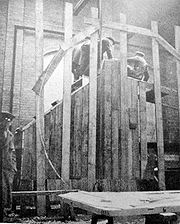
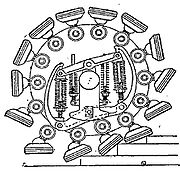

Duncan John Glasfurd
Brigadier General Duncan John Glasfurd was a British Army and later Australian Army colonel and temporary Brigadier General in World War I. He was mentioned in dispatches for his role in evacuating Anzac...
, who was fighting in France, proposed an idea for a pedrail machine which could attack enemy lines.
In May 1915, the War Office made new tests on a trench-crossing machine: the Tritton Trench-Crosser. The machine was equipped with large tractor wheels, 8 feet in diameter, and carried girder
Girder
A girder is a support beam used in construction. Girders often have an I-beam cross section for strength, but may also have a box shape, Z shape or other forms. Girder is the term used to denote the main horizontal support of a structure which supports smaller beams...
s on an endless chain which were lowered above a trench so that the back wheels could roll over it. The machine would then drag the girder behind until on flat terrain, so that it could reverse over them and set them back in place in front of the vehicle. The machine proved much too cumbersome and was abandoned.
When Winston Churchill
Winston Churchill
Sir Winston Leonard Spencer-Churchill, was a predominantly Conservative British politician and statesman known for his leadership of the United Kingdom during the Second World War. He is widely regarded as one of the greatest wartime leaders of the century and served as Prime Minister twice...
, First Lord of the Admiralty, learned of the armored tractor idea, he reignited investigation of the idea of using the Holt tractor. The Royal Navy
Royal Navy
The Royal Navy is the naval warfare service branch of the British Armed Forces. Founded in the 16th century, it is the oldest service branch and is known as the Senior Service...
and the Landships Committee
Landships Committee
The Landships Committee was a small British war cabinet committee established in February 1915 to deal with the design and construction of what would turn out to be tanks during the First World War...
(established on 20 February 1915), at last agreed to sponsor experiments and tests of armoured tractors as a type of "land ship". In March, Churchill ordered the building of 18 experimental landship
Landship
A landship is a large vehicle that travels on land, as opposed to on water, air, or in space. Because of their large size, their use on land is seen as impractical due to terrain obstacles, and soft ground that cannot support such large weight. Such problems are non-existent on water and in space...
s: 12 using Diplock
Bramah Joseph Diplock
Bramah Joseph Diplock was an English inventor who invented the pedrail wheel in 1903.He also invented the pedrail locomotive which was featured in the 7 February 1904 New York Times....
pedrails (an idea promoted by Murray Sueter
Murray Sueter
Sir Murray Fraser Sueter, CB, MP was a Royal Naval officer who was noted as a pioneer of naval aviation and later became a Member of Parliament .-Naval career:...
), and 6 using large wheels (the idea of T.G. Hetherington). Construction however failed to move forward, as the wheels seemed impractical after a wooden mock-up was realized: the wheels were initially planned to be 40-feet in diameter, but turned out to be still too big and too fragile at 15-feet. The pedrails also met with industrial problems, and the system was deemed too large, too complicated and under-powered.
Instead of choosing to use the Holt tractor, the British government chose to involve a British agricultural machinert firm, Foster and Sons
William Foster & Co.
William Foster & Co Ltd was an agricultural machinery company based in Lincoln, Lincolnshire, England and usually just called "Fosters of Lincoln." The company can be traced back to 1846, when William Foster purchased a flour mill in Lincoln. William Foster then proceeded to start small scale...
, whose managing director and designer was Sir William Tritton
William Tritton
Sir William Ashbee Tritton, M.I.Mech.E., J.P. was an expert in agricultural machinery, and was directly involved, together with Major Walter Gordon Wilson, in the development of the tank...
.

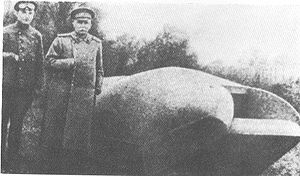
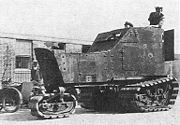
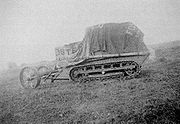
Another experiment was made with tracks brought from the United States from the Killen-Strait tractor. A wire-cutting mechanism was successfully fitted, but the trench-crossing capability of the Killen-Strait proved insufficient. A Delaunay-Belleville
Delaunay-Belleville
Automobiles Delaunay-Belleville was a French luxury automobile manufacturer from Saint-Denis, France, north of Paris. At the beginning of the 20th century they were among the most prestigious cars produced in the world, and perhaps the most desirable French marque.Julien Belleville had been a maker...
armoured car body was fitted, making the Killen-Strait machine the first armoured tracked vehicle, but the project was abandoned as it turned out to be a blind alley, unable to fulfill all-terrain warfare requirements.
After these experiments, the Committee decided to build a smaller experimental landship, equivalent to one half the articulated version, and using lengthened US-made Bullock Creeping Grip caterpillar tracks. This new experimental machine was called the No1 Lincoln Machine: construction started on 11 August 1915, with the first trials starting on 10 September 1915. These trials failed however because of unsatisfactory tracks.
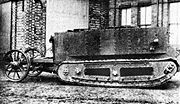
Little Willie
Little Willie was a prototype in the development of the British Mark I tank. Constructed in the summer of 1915 through a close cooperation of the military and industry of the United Kingdom, it was the first completed tank prototype in history...
, was completed in December 1915 and tested on 3 December 1915. Trench-crossing ability was deemed insufficient however, and Walter Gordon Wilson
Walter Gordon Wilson
Major Walter Gordon Wilson was an engineer and member of the British Royal Naval Air Service. He was credited by the 1919 Royal Commission on Awards to Inventors as the co-inventor of the tank, along with Sir William Tritton....
developed a rhomboidal design, which became known as "His Majesty's Landship Centipede" and later "Mother", the first of the "Big Willie" types of true tanks. After completion on 29 January 1916 very successful trials were made, and an order was placed by the War Office for 100 units to be used on the Western front in France, on 12 February 1916, and a second order for 50 additional units was placed in April 1916.
France started studying caterpillar continuous tracks from January 1915, and actual tests started in May 1915, two months earlier than the Little Willie experiments. At the Souain experiment
Souain experiment
The Souain experiment was a French military experiment using a prototype tank, in the former battlefield of Souain, in northeastern France, on 9 December 1915. The experiment has a decisive influence of the French tank program and initiated the design and order of the first French operational tank,...
, France tested an armoured tracked tank prototype, the same month Little Willie was completed.Ultimately however, the British were the first to put tanks on the battlefield, at the battle of the Somme in September 1916.
The name "tank" was introduced in October, 1915 as a security measure and has been adopted in many languages. William Tritton, stated that when the prototypes were under construction from August, 1915 they were deliberately falsely described in order to conceal their true purpose. In the workshop the paperwork described them as "water carriers," supposedly for use on the Mesopotamian Front. In conversation the workers referred to them as "water tanks" or, simply, "tanks." In October the Landships Committee decided, for security purposes, to change its own name to something less descriptive. One of the members (either Eustace d'Eyncourt or Ernest Swinton) suggested "tank," and the committee agreed. It became the Tank Supply Committee, and the name "tank" was used in official documents and common parlance from then on. This is sometimes confused with the labelling of the first production tanks (ordered in February, 1916) with a caption in Russian. It translated as "With Care to Petrograd," probably again inspired by the workers at Foster's, some of whom believed the machines to be snowploughs meant for Russia, and was introduced from May 15, 1916. The Committee was happy to perpetuate this misconception since it might also mislead the Germans.
The naval background of the tank's development also explains such nautical tank terms as hatch, hull, bow, and ports. The great secrecy surrounding tank development, coupled with the skepticism of infantry commanders, often meant that infantry at first had little training to cooperate with tanks.
Russian development
Mendeleev Tank (1911–1914, project; Russian Wikipedia article)Vezdekhod
Vezdekhod
The Vezdekhod was the first true tank to be developed by Imperial Russia. The word Vezdekhod means: "He who goes anywhere" or "all-terrain vehicle". It did not however progress further than a pre-production model, due to problems in the design.-Design:...
(1914–1915)
Lebedenko Tank (1915–1916)
Gulkevich Tractor (1915–1916; Russian Wikipedia article)
Operational use in World War I

Cambrai
Cambrai is a commune in the Nord department in northern France. It is a sub-prefecture of the department.Cambrai is the seat of an archdiocese whose jurisdiction was immense during the Middle Ages. The territory of the Bishopric of Cambrai, roughly coinciding with the shire of Brabant, included...
, did the British Tank Corps
Royal Tank Regiment
The Royal Tank Regiment is an armoured regiment of the British Army. It was formerly known as the Tank Corps and the Royal Tank Corps. It is part of the Royal Armoured Corps and is made up of two operational regiments, the 1st Royal Tank Regiment and the 2nd Royal Tank Regiment...
get the conditions it needed for success. Around 400 tanks penetrated almost six miles on a 7-mile front. This was their first large-scale deployment in combat. Unfortunately, success was not complete because the infantry failed to exploit and secure the tanks' gains. The British scored another victory the following year, on 8 August 1918, with 600 tanks in the Amiens salient. General Erich Ludendorff
Erich Ludendorff
Erich Friedrich Wilhelm Ludendorff was a German general, victor of Liège and of the Battle of Tannenberg...
referred to that date as the "Black Day" of the German Army.

A7V
The A7V was a tank introduced by Germany in 1918, near the end of World War I. One hundred vehicles were ordered during the spring of 1918, but only 21 were delivered. It was nicknamed "The Moving Fortress" by the British because of the shape of the hull...
appeared. The A7V was a clumsy monster, weighing 30 tons with a crew of eighteen. By the end of the war, only fifteen had been built. Although other tanks were on the drawing board, material shortages limited the German tank corps to these A7Vs and some captured Mark IVs. The A7V would be involved in the first tank vs. tank battle of the war on April 24, 1918 at the Second Battle of Villers-Bretonneux
Second Battle of Villers-Bretonneux
The Second Battle of Villers-Bretonneux came during the period of the battle of Lys, 24–27 April 1918, but was launched against the British lines in front of Amiens.The Germans developed a small number of tanks, and used them in this offensive...
—a battle in which there was no clear winner.
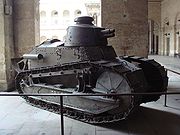
France
The French Republic , The French Republic , The French Republic , (commonly known as France , is a unitary semi-presidential republic in Western Europe with several overseas territories and islands located on other continents and in the Indian, Pacific, and Atlantic oceans. Metropolitan France...
designed its own tanks. The first two, the medium Schneider CA
Schneider CA1
The Schneider CA1 was the first French tank. It was inspired by the need to overcome the stalemate of the trench warfare of the Great War.-Caterpillar development:...
and heavy St Chamond
St Chamond (tank)
The Saint-Chamond was the second French heavy tank of the First World War.Overall an inadequate design born of commercial rivalry, the war ended before it was replaced by British heavy tanks.-Development:...
, were not well-conceived, though produced in large numbers and showing technical innovations, the latter using a electro-mechanical transmission and a long 75 mm gun. The later Renault FT
Renault FT-17
The Renault FT, frequently referred to in post-WWI literature as the "FT-17" or "FT17" , was a French light tank; it is among the most revolutionary and influential tank designs in history...
was the first tank in history with a "modern" configuration: a revolving turret on top and an engine compartment in the back; it would be the most numerous tank of the war. A last development was the superheavy Char 2C
Char 2C
The Char 2C was a French super-heavy tank developed, although never deployed, during World War I. It was the largest operational tank ever.-Development:...
, the largest tank ever to see service, be it some years after the armistice.
Numerous mechanical failures and the inability of the British and French to mount any sustained drives in the early tank actions cast doubt on their usefulness—and by 1918, tanks were extremely vulnerable unless accompanied by infantry and ground-attack aircraft, both of which worked to locate and suppress anti-tank
Anti-tank warfare
Anti-tank warfare was created by the need to seek technology and tactics to destroy tanks and their supporting infantry during the First World War...
defenses.
But Gen. John J. Pershing
John J. Pershing
John Joseph "Black Jack" Pershing, GCB , was a general officer in the United States Army who led the American Expeditionary Forces in World War I...
, Commander in Chief, American Expeditionary Force
American Expeditionary Force
The American Expeditionary Forces or AEF were the United States Armed Forces sent to Europe in World War I. During the United States campaigns in World War I the AEF fought in France alongside British and French allied forces in the last year of the war, against Imperial German forces...
s (AEF), requested in September 1917 that 600 heavy and 1,200 light tanks be produced in the United States. When General Pershing assumed command of the American Expeditionary Force and went to France, he took Lt. Col. George Patton. Patton became interested in tanks. They were then unwieldy, unreliable, and unproved instruments of warfare, and there was much doubt whether they had any function and value at all on the battlefield. Against the advice of most of his friends, Patton chose to go into the newly formed US Tank Corps. He was the first officer so assigned.
The first American-produced heavy tank was the 43.5-ton Mark VIII
Mark VIII (tank)
The Tank Mark VIII or Liberty was an Anglo-American tank design of the First World War. Initially intended to be a collaborative effort to equip France, the UK and the US with a single tank design, it did not come to fruition before the end of the war and only a few were produced.-Early...
, a US-British development of the successful British heavy tank design. Armed with two 6-pounder and five .30-caliber machine guns, it was operated by an 11-man crew, had a maximum speed of 6.5 miles per hour, and a range of 50 miles. The American-built 6.5-ton M1917 light tank was a copy of the French Renault FT-17. It had a maximum speed of 5.5 miles per hour and could travel 30 miles on its 30-gallon fuel capacity. The US program was augmented in the summer of 1918 by the development of a 3-ton, 2-man tank, (Ford 3-Ton M1918
Ford 3-Ton M1918
The Ford 3-Ton M1918 was one of the first light tank designs by the U.S. It was a small two-man, one-gun tank. It was armed with a M1919 Browning machine gun and could reach a maximum speed of 8mph.-History:...
) originated by the Ford Motor Company
Ford Motor Company
Ford Motor Company is an American multinational automaker based in Dearborn, Michigan, a suburb of Detroit. The automaker was founded by Henry Ford and incorporated on June 16, 1903. In addition to the Ford and Lincoln brands, Ford also owns a small stake in Mazda in Japan and Aston Martin in the UK...
. This third tank to be mass-produced during 1918 was powered by two Ford Model T, 4-cylinder engines, armed with a .30-caliber machine gun, and had a maximum speed of 8 miles per hour.
American tank units first entered combat on 12 September 1918 against the St. Mihiel salient with the First Army. They belonged to the 344th and 345th Light Tank Battalions, elements of the 304th Tank Brigade, commanded by Lt. Col. Patton, under whom they had trained at the tank center in Bourg, France. Although mud, lack of fuel, and mechanical failure caused many tanks to stall in the German trenches, the attack succeeded and much valuable experience was gained. By the armistice of 11 November 1918, the AEF was critically short of tanks, as no American-made ones were completed in time for use in combat.
Between the wars

At the war's end, the main role of the tank was considered to be that of close support for the infantry. The U.S. tank units fought so briefly and were so fragmented during the war, and the number of tanks available to them was so limited, that there was practically no opportunity to develop tactics for their large-scale employment. Nonetheless, their work was sufficiently impressive to imbue at least a few military leaders with the idea that the use of tanks in mass was the most likely principal role of armor in the future.
Highlights of U.S. Army appraisal for the development and use of tanks, developed from combat experience, were: (1) the need for a tank with more power, fewer mechanical failures, heavier armor, longer operating range, and better ventilation; (2) the need for combined training of tanks with other combat arms, especially the infantry; (3) the need for improved means of communication and of methods for determining and maintaining directions; and (4) the need for an improved supply system, especially for gasoline and ammunition.
Although the tank of World War I was slow, clumsy, unwieldy, difficult to control, and mechanically unreliable, its value as a combat weapon had been clearly proven. But, despite the lessons of World War I, the combat arms were most reluctant to accept a separate and independent role for armor and continued to struggle among themselves over the proper use of tanks. At the outset, thought of the tank as an auxiliary to and a part of the infantry was the predominant opinion, although a few leaders contended that an independent tank arm should be retained.
In addition to the light and heavy categories of American-produced tanks of World War I, a third classification, the medium, began receiving attention in 1919. It was hoped that this in-between type would incorporate the best features of the 6½-ton light and the Mark VIII heavy and would replace both. The meaning of the terms light, medium, and heavy tanks changed between the wars. During World War I and immediately thereafter, the light tank was considered to be up to 10 tons, the medium (produced by the British) was roughly between 10 and 25 tons, and the heavy was over 25 tons. For World War II, increased weights resulted in the light tank being over 20 tons, the medium over 30, and the heavy, developed toward the end of the war, over 60 tons. During the period between the world wars, the weights of the classifications varied generally within these extremes.
The U.S. National Defense Act of 1920 placed the Tank Corps under the Infantry. The Act's stipulation that "hereafter all tank units shall form a part of the Infantry" left little doubt as to the tank role for the immediate future. George Patton had argued for an independent Tank Corps. But if, in the interest of economy, the tanks had to go under one of the traditional arms, he preferred the cavalry, for Patton intuitively understood that tanks operating with cavalry would stress mobility, while tanks tied to the infantry would emphasize firepower. Tanks in peacetime, he feared, as he said, "would be very much like coast artillery with a lot of machinery which never works."
At a time when most soldiers regarded the tank as a specialized infantry-support weapon for crossing trenches, a significant number of officers in the Royal Tank Corps had gone on to envision much broader roles for mechanized organizations. In May 1918, Col. J.F.C. Fuller
J.F.C. Fuller
Major-General John Frederick Charles Fuller, CB, CBE, DSO was a British Army officer, military historian and strategist, notable as an early theorist of modern armoured warfare, including categorising principles of warfare...
, the acknowledged father of tank doctrine, had used the example of German infiltration tactics to refine what he called "Plan 1919
Plan 1919
Plan 1919 was a military strategy drawn up by J.F.C. Fuller in 1918 during World War I. His plan criticised the practice of physically destroying the enemy, and instead suggested a lightning thrust toward the command center of the German army...
". This was an elaborate concept for a large-scale armored offensive in 1919.
The Royal Tank Corps had to make do with the same basic tanks from 1922 until 1938. British armored theorists did not always agree with each other. B. H. Liddell Hart, a noted publicist of armor, wanted a true combined arms force with a major role for mechanized infantry. Fuller, Broad, and other officers were more interested in a pure-tank role. The Experimental Mechanized Force
Experimental Mechanized Force
The Experimental Mechanized Force was a brigade-sized formation of the British Army. It was officially formed on 27 August 1927, and was intended to investigate and develop the techniques and equipment required for armoured warfare. It was renamed the Experimental Armoured Force the following year...
formed by the British demonstrated a mobile force with its own self-propelled guns.
Both advocates and opponents of mechanization often used the term "tank" loosely to mean not only an armored, tracked, turreted, gun-carrying fighting vehicle, but also any form of armored vehicle or mechanized unit. Such usage made it difficult for contemporaries or historians to determine whether a particular speaker was discussing pure tank forces, mechanized combined arms forces, or mechanization of infantry forces.
British armored vehicles tended to maximize either mobility or protection. Both the cavalry and the Royal Tank Corps wanted fast, lightly armored, mobile vehicles for reconnaissance and raiding—the light and medium (or "cruiser") tanks. In practice the "light tanks" were often small armored personnel carriers (the parallel with more recent American Armored Cavalry should be obvious). On the other hand, the "army tank battalions" performing the traditional infantry-support role required extremely heavy armored protection. As a consequence of these two doctrinal roles, firepower was neglected in tank design.
Among the German proponents of mechanization, Gen. Heinz Guderian
Heinz Guderian
Heinz Wilhelm Guderian was a German general during World War II. He was a pioneer in the development of armored warfare, and was the leading proponent of tanks and mechanization in the Wehrmacht . Germany's panzer forces were raised and organized under his direction as Chief of Mobile Forces...
was probably the most influential. Guderian's 1914 service with radiotelegraphs in support of cavalry units led him to insist on a radio in every armored vehicle. By 1929, when many British students of armor were tending towards a pure armor formation, Guderian had become convinced that it was useless to develop just tanks, or even to mechanize parts of the traditional arms. What was needed was an entirely new mechanized formation of all arms that would maximize the effects of the tank.
The German tanks were not up to the standards of Guderian's concept. The Panzer I
Panzer I
The Panzer I was a light tank produced in Germany in the 1930s. The name is short for the German ' , abbreviated . The tank's official German ordnance inventory designation was SdKfz 101 .Design of the Panzer I began in 1932 and mass production in 1934...
was really a machine-gun-armed tankette, derived from the British Carden-Loyd personnel carrier. The Panzer II
Panzer II
The Panzer II was the common name for a family of German tanks used in World War II. The official German designation was Panzerkampfwagen II...
did have a 20-mm cannon, but little armor protection. These two vehicles made up the bulk of panzer units until 1940.
In the twenties France was the only country in the world with a large armour force. French doctrine viewed combined arms as a process by which all other weapons systems assisted the infantry in its forward progress. Tanks were considered to be "a sort of armoured infantry", by law subordinated to the infantry branch. This at least had the advantage that armour was not restricted purely to tanks; the French army would be among the most mechanised. Tanks proper were however first of all seen as specialised breakthrough systems, to be concentrated for an offensive: light tanks had to limit their speed to that of the foot soldier; heavy tanks were intended to form a forward "shock front" to dislodge defensive lines. The doctrine was much preoccupied with the strength of the defender: artillery and air bombardments had to destroy machine guns and anti-tank guns. The envelopment phase was neglected. Though part of the Infantry branch, tanks were in fact concentrated in almost pure tank units and rarely trained together with foot soldiers.
In 1931, France decided to produce armour and other equipment in larger quantities, including the Char B1 bis
Char B1
The Char B1 was a French heavy tank manufactured before World War II.The Char B1 was a specialised heavy break-through vehicle, originally conceived as a self-propelled gun with a 75 mm howitzer in the hull; later a 47 mm gun in a turret was added, to allow it to function also as a Char...
. The B1 bis, developed by Estienne in the early 1920s, was still one of the most powerful tank designs in the world fifteen years later. In 1934 the French cavalry also began a process of mechanisation; tanks were to be used for exploitation also.
As the French Army was moving forward in the area of mechanization, doctrinal strife began to develop. In 1934, Lieutenant Colonel Charles de Gaulle
Charles de Gaulle
Charles André Joseph Marie de Gaulle was a French general and statesman who led the Free French Forces during World War II. He later founded the French Fifth Republic in 1958 and served as its first President from 1959 to 1969....
published Towards the Professional Army. De Gaulle favoured a professional mechanised force, capable of executing both the breakthrough and the exploitation phase. He envisioned a pure armour brigade operating in linear formation, followed by a motorized infantry force for mopping-up. His ideas were not adopted, as being too expensive.
From 1936 French tank production accelerated, but the doctrinal problems remained, resulting in 1940 in an inflexible structure, with the Infantry and Cavalry fielding separate types of armoured division.
During the course of the 1920s and early 1930s, a group of Soviet officers led by Marshal Mikhail Tukhachevsky
Mikhail Tukhachevsky
Mikhail Nikolayevich Tukhachevsky was a Marshal of the Soviet Union, commander in chief of the Red Army , and one of the most prominent victims of Joseph Stalin's Great Purge.-Early life:...
developed a concept of "Deep Battle" to employ conventional infantry and cavalry divisions, mechanized formations, and aviation in concert. Using the expanded production facilities of the Soviet government's first Five Year Plan with design features taken in part from the American inventor J. Walter Christie
J. Walter Christie
John Walter Christie was an American engineer and inventor. He is best known for developing the Christie suspension system used in a number of World War II-era tank designs, most notably the Soviet BT and T-34 series, and the British Covenanter and Crusader Cruiser tanks, as well as the Comet...
, the Soviets produced 5,000 armored vehicles by 1934. This wealth of equipment enabled the Red Army to create tank organizations for both infantry support and combined arms, mechanized operations.
On 12 June 1937, the Soviet government executed Tukhachevsky and eight of his high-ranking officers, as Stalin shifted his purge of Soviet society against the last power group that had the potential to threaten him, the Red Army. At the same time, the Soviet experience in the Spanish Civil War caused the Red Army to reassess mechanization. The Soviet tanks were too lightly armored, their Russian crews could not communicate with the Spanish troops, and in combat the tanks tended to outpace the supporting infantry and artillery.
The United States was not nearly so advanced in the development of armored and mechanized forces. As in France, the supply of slow World War I tanks and the subordination of tanks to the infantry branch impeded the development of any role other than direct infantry support. The US War Department policy statement, which finally came in April 1922, was a serious blow to tank development. Reflecting prevailing opinion, it stated that the tank's primary mission was "to facilitate the uninterrupted advance of the riflemen in the attack." The War Department considered that two types of tanks, the light and the medium, should fulfill all missions. The light tank was to be truck transportable and not exceed 5 tons gross weight. For the medium, restrictions were even more stringent; its weight was not to exceed 15 tons, so as to bring it within the weight capacity of railroad flatcars, the average existing highway bridge, and, most significantly, available Engineer Corps pontoon bridges.
Although an experimental 15-ton tank, the M1924, reached the mock-up stage, this and other attempts to satisfy War Department and infantry specifications proved to be unsatisfactory. In reality it was simply impossible to build a 15-ton vehicle meeting both War Department and infantry requirements.
In 1926 the General Staff reluctantly consented to the development of a 23-ton tank, although it made clear that efforts were to continue toward the production of a satisfactory 15-ton vehicle. The infantry—its new branch chief overriding the protests of some of his tankmen who wanted a more heavily armed and armored medium—decided, too, that a light tank, transportable by truck, best met infantry requirements. The net effect of the infantry's preoccupation with light tanks and the limited funds available for tank development in general was to slow the development of heavier vehicles and, ultimately, to contribute to the serious shortage of mediums at the outbreak of World War II.
J. Walter Christie
J. Walter Christie
John Walter Christie was an American engineer and inventor. He is best known for developing the Christie suspension system used in a number of World War II-era tank designs, most notably the Soviet BT and T-34 series, and the British Covenanter and Crusader Cruiser tanks, as well as the Comet...
was an innovative designer of tanks, engines and propulsion systems. Although his designs did not meet US Army specifications, other countries used his chassis patents. Despite inadequate funding, the Ordnance Department managed to develop several experimental light and medium tanks and tested one of Walter Christie's models by 1929. None of these tanks was accepted, usually because each of them exceeded standards set by other Army branches. For instance, several light tank models were rejected because they exceeded the 5-ton cargo capacity of the Transportation Corps trucks, and several medium tank designs were rejected because they exceeded the 15-ton bridge weight limit set by the engineers. Christie simply would not work with users to fulfill the military requirements but, instead, wanted the Army to fund the tanks that he wanted to build. Patton later worked closely with J. Walter Christie to improve the silhouette, suspension, power, and weapons of tanks.
The Christie tank embodied the ability to operate both on tracks and on large, solid-rubber-tired bogie wheels. The tracks were removable to permit operation on wheels over moderate terrain. Also featured was a suspension system of independently sprung wheels. The Christie had many advantages, including the amazing ability, by 1929, to attain speeds of 69 miles per hour on wheels and 42 miles per hour on tracks, although at these speeds the tank could not carry full equipment. To the infantry and cavalry the Christie was the best answer to their need for a fast, lightweight tank, and they were enthusiastic about its convertibility. On the other hand, the Ordnance Department, while recognizing the usefulness of the Christie, was of the opinion that it was mechanically unreliable and that such dual-purpose equipment generally violated good engineering practice. The controversy over the advantages and drawbacks of Christie tanks raged for more than twenty years, with the convertible principle being abandoned in 1938. But the Christie ideas had great impact upon tank tactics and unit organization in many countries and, finally, upon the US Army as well.
In the United States the real beginning of the Armored Force was in 1928, twelve years before it was officially established, when Secretary of War Dwight F. Davis
Dwight F. Davis
Dwight Filley Davis was an American tennis player and politician. He is best remembered as the founder of the Davis Cup international tennis competition.-Biography:...
directed that a tank force be developed in the Army. Earlier that year he had been much impressed, as an observer of maneuvers in England, by a British Experimental Armored Force. Actually the idea was not new. A small group of dedicated officers in the cavalry and the infantry had been hard at work since World War I on theories for such a force. The continued progress in the design of armor, armament, engines, and vehicles was gradually swinging the trend toward more mechanization, and the military value of the horse declined. Proponents of mechanization and motorization pointed to advances in the motor vehicle industry and to the corresponding decrease in the use of horses and mules. Furthermore, abundant oil resources gave the United States an enviable position of independence in fuel requirements for the machines.
Secretary Davis' 1928 directive for the development of a tank force resulted in the assembly and encampment of an experimental mechanized force at Camp Meade, Maryland, from 1 July to 20 September 1928. The combined arms team consisted of elements furnished by Infantry (including tanks), Cavalry, Field Artillery, the Air Corps, Engineer Corps, Ordnance Department, Chemical Warfare Service, and Medical Corps. An effort to continue the experiment in 1929 was defeated by insufficient funds and obsolete equipment, but the 1928 exercise did bear fruit, for the War Department Mechanization Board, appointed to study results of the experiment, recommended the permanent establishment of a mechanized force.
As Chief of Staff from 1930 to 1935, Douglas MacArthur
Douglas MacArthur
General of the Army Douglas MacArthur was an American general and field marshal of the Philippine Army. He was a Chief of Staff of the United States Army during the 1930s and played a prominent role in the Pacific theater during World War II. He received the Medal of Honor for his service in the...
wanted to advance motorization and mechanization throughout the army. In late 1931 all arms and services were directed to adopt mechanization and motorization, "as far as is practicable and desirable", and were permitted to conduct research and to experiment as necessary. Cavalry was given the task of developing combat vehicles that would "enhance its power in roles of reconnaissance, counterreconnaissance, flank action, pursuit, and similar operations." By law, "tanks" belonged to the infantry branch, so the cavalry gradually bought a group of "combat cars", lightly armored and armed tanks that were often indistinguishable from the newer infantry "tanks."
In 1933 MacArthur set the stage for the coming complete mechanization of the cavalry, declaring, "The horse has no higher degree of mobility today than he had a thousand years ago. The time has therefore arrived when the Cavalry arm must either replace or assist the horse as a means of transportation, or else pass into the limbo of discarded military formations." Although the horse was not yet claimed to be obsolete, his competition was gaining rapidly, and realistic cavalrymen, sensing possible extinction, looked to at least partial substitution of the faster machines for horses in cavalry units.
The War Department in 1938 modified its 1931 directive for all arms and services to adopt mechanization and motorization. Thereafter, development of mechanization was to be accomplished by two of the combat arms only—the cavalry and the infantry. As late as 1938, on the other hand, the Chief of Cavalry, Maj. Gen. John K. Herr
John Knowles Herr
John Knowles Herr was a career American soldier. Herr served forty years in the United States Cavalry and participated in the final battles of World War I as chief of staff of the 30th Division, but is best remembered for being the last Chief of U. S. Cavalry in history...
, proclaimed, "We must not be misled to our own detriment to assume that the untried machine can displace the proved and tried horse." He favored a balanced force made up of both horse and mechanized cavalry. In testimony before a Congressional committee in 1939, Maj. Gen. John K. Herr maintained that horse cavalry had "stood the acid test of war", whereas the motor elements advocated by some to replace it had not.
Actually, between the world wars there was much theoretical but little tangible progress in tank production and tank tactics in the United States. Production was limited to a few hand-tooled test models, only thirty-five of which were built between 1920 and 1935. Regarding the use of tanks with infantry, the official doctrine of 1939 largely reiterated that of 1923. It maintained that "As a rule, tanks are employed to assist the advance of infantry foot troops, either preceding or accompanying the infantry assault echelon."
In the 1930s the American Army began to seriously discuss the integration of the tank and the airplane into existing doctrine, but the US Army remained an infantry-centered Army, even though sufficient changes had occurred to warrant serious study. In the spring of 1940, maneuvers in Georgia and Louisiana, where Patton was an umpire, showed how far Chaffee had brought the development of American armored doctrine.
World War II
.jpg)
Armor experts in most armies, however, were determined to avoid being tied to the infantry, and in any event a tank was an extremely complicated, expensive, and therefore scarce weapon. The British persisted for much of the war on a dual track of development, retaining Infantry tanks to support the infantry and lighter, more mobile cruiser tanks for independent armored formations. The Soviets similarly produced an entire series of heavy breakthrough tanks.
During the war, German tank design went through at least three generations, plus constant minor variations. The first generation included such prewar vehicles as the Panzerkampfwagen (or Panzer) I and II, which were similar to Soviet and British light tanks. The Germans converted their tank battalions to a majority of Panzer III
Panzer III
Panzer III was the common name of a medium tank that was developed in the 1930s by Germany and was used extensively in World War II. The official German designation was Panzerkampfwagen III translating as "armoured battle vehicle". It was intended to fight other armoured fighting vehicles and...
and Panzer IV
Panzer IV
The Panzerkampfwagen IV , commonly known as the Panzer IV, was a medium tank developed in Nazi Germany in the late 1930s and used extensively during the Second World War. Its ordnance inventory designation was Sd.Kfz...
medium tanks after the 1940 French campaign. However, the appearance of large numbers of the new generation T-34
T-34
The T-34 was a Soviet medium tank produced from 1940 to 1958. Although its armour and armament were surpassed by later tanks of the era, it has been often credited as the most effective, efficient and influential design of World War II...
and KV-1 Soviet tanks, that were unknown to Germans until 1941, compelled them to join a race for superior armor and gunpower. The third generation included many different variants, but the most important designs were the Panther (Panzer V)
Panther tank
Panther is the common name of a medium tank fielded by Nazi Germany in World War II that served from mid-1943 to the end of the European war in 1945. It was intended as a counter to the T-34, and to replace the Panzer III and Panzer IV; while never replacing the latter, it served alongside it as...
and Tiger (Panzer VI)
Tiger I
Tiger I is the common name of a German heavy tank developed in 1942 and used in World War II. The final official German designation was Panzerkampfwagen Tiger Ausf. E, often shortened to Tiger. It was an answer to the unexpectedly formidable Soviet armour encountered in the initial months of...
tanks. Unfortunately for the Germans, lack of resources combined with emphasis on protection and firepower compromised the production numbers. In 1943, for example, Germany manufactured only 5,966 tanks, as compared to 29,497 for the US, 7,476 for Britain, and an estimated 20,000 for the Soviet Union.
The alternative to constant changes in tank design was to standardize a few basic designs and mass produce them even though technology had advanced to new improvements. This was the solution of Germany's principal opponents. The Soviet T-34, for example, was an excellent basic design that survived the war with only one major change in armament, 76.2-mm to 85-mm main gun.
The United States had even more reason to standardize and mass produce than did the Soviet Union. By concentrating on mechanical reliability, the US was able to produce vehicles that operated longer with fewer repair parts. To ensure that American tanks were compatible with American bridging equipment, the War Department restricted tank width and maximum weight to thirty tons. The army relaxed these requirements only in late 1944.
When Germany invaded western Europe in 1940, the US Army had only 28 new tanks- 18 medium and 10 light- and these were soon to become obsolete, along with some 900 older models on hand. The Army had no heavy tanks and no immediate plans for any. Even more serious than the shortage of tanks was industry's lack of experience in tank manufacture and limited production facilities. Furthermore, the United States was committed to helping supply its allies. By 1942 American tank production had soared to just under 25,000, almost doubling the combined British and German output for that year. And in 1943, the peak tank production year, the total was 29,497. All in all, from 1940 through 1945, US tank production totaled 88,410.
Tank designs of World War II were based upon many complex considerations, but the principal factors were those thought to be best supported by combat experience. Among these, early combat proved that a bigger tank was not necessarily a better tank. The development goal came to be a tank combining all the proven characteristics in proper balance, to which weight and size were only incidentally related. The key characteristics were mechanical reliability, firepower, mobility and protection.
The problem here was that only a slight addition to the thickness of armor plate greatly increased the total weight of the tank, thereby requiring a more powerful and heavier engine. This, in turn, resulted in a larger and heavier transmission and suspension system. All of these pyramiding increases tended to make the tank less maneuverable, slower, and a larger and easier target. Determining the point at which the optimum thickness of armor was reached, in balance with other factors, presented a challenge that resulted in numerous proposed solutions and much disagreement.
According to Lt. Gen. Lesley J. McNair, Chief of Staff of GHQ, and later Commanding General, Army Ground Forces, the answer to bigger enemy tanks was more powerful guns instead of increased size.
Since emphasis of the using arms was upon light tanks during 1940 and 1941, their production at first was almost two to one over the mediums. But in 1943, as the demand grew for more powerful tanks, the lights fell behind, and by 1945 the number of light tanks produced was less than half the number of mediums.
In 1945-46, the General Board of the US European Theater of Operations conducted an exhaustive review of past and future organization. The tank destroyer was deemed too specialized to justify in a peacetime force structure. In a reversal of previous doctrine, the US Army concluded that "the medium tank is the best antitank weapon." Although such a statement may have been true, it ignored the difficulties of designing a tank that could outshoot and defeat all other tanks.
The Cold War
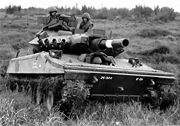
Warsaw Pact
The Warsaw Treaty Organization of Friendship, Cooperation, and Mutual Assistance , or more commonly referred to as the Warsaw Pact, was a mutual defense treaty subscribed to by eight communist states in Eastern Europe...
countries on the one side, and the NATO countries on the other side.
Soviet domination of the Warsaw Pact led to effective standardization on a few tank designs. In comparison, NATO adopted a defensive posture. The major contributing nations, France, Germany, the USA, and the UK developed their own tank designs, with little in common.
After World War II, tank development continued. Tanks would not only continue to be produced in huge numbers, but the technology advanced dramatically as well. Medium tanks became heavier, their armour became thicker and their firepower increased. This led gradually to the concept of the main battle tank
Main battle tank
A main battle tank , also known as a battle tank or universal tank, is a tank that fills the heavy direct fire role of many modern armies. They were originally conceived to replace the light, medium, heavy and super-heavy tanks. Development was spurred onwards in the Cold War with the development...
and the gradual elimination of the heavy tank. Aspects of gun technology changed significantly as well, with advances in shell design and effectiveness.
Many of the changes in tank design have been refinements to targeting and ranging (fire control
Fire-control system
A fire-control system is a number of components working together, usually a gun data computer, a director, and radar, which is designed to assist a weapon system in hitting its target. It performs the same task as a human gunner firing a weapon, but attempts to do so faster and more...
), gun stabilization, communications and crew comfort. Armour evolved to keep pace with improvements in weaponry - the rise of composite armour
Composite armour
Composite armour is a type of vehicle armour consisting of layers of different material such as metals, plastics, ceramics or air. Most composite armour are lighter than their all-metal equivalent, but instead occupy a larger volume for the same resistance to penetration...
is of particular note - and guns grew more powerful. However, basic tank architecture did not change significantly, and has remained largely the same into the 21st century.
Entering the 21st century
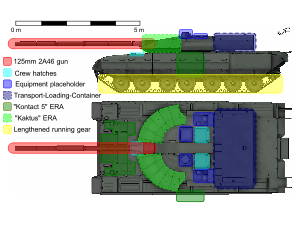
Cold War
The Cold War was the continuing state from roughly 1946 to 1991 of political conflict, military tension, proxy wars, and economic competition between the Communist World—primarily the Soviet Union and its satellite states and allies—and the powers of the Western world, primarily the United States...
in 1991, questions once again started sprouting concerning the relevance of the traditional tank. Over the years, many nations cut back the number of their tanks or replaced most of them with lightweight armoured fighting vehicle
Armoured fighting vehicle
An armoured fighting vehicle is a combat vehicle, protected by strong armour and armed with weapons. AFVs can be wheeled or tracked....
s with only minimal armour protection.
This period also brought an end to the superpower blocs, and the military industries of Russia and Ukraine are now vying to sell tanks worldwide. India and Pakistan have upgraded old tanks and bought new T-84
T-84
The T-84 is a Ukrainian main battle tank, a development of the Soviet T-80 main battle tank. It was first built in 1994 and entered service in the Ukrainian Armed Forces in 1999. The T-84 is based on the diesel-engined T-80 version, the T-80UD...
s and T-90
T-90
The T-90 is a Russian third-generation main battle tank that is a modernisation of the T-72 . It is currently the most modern tank in service with the Russian Ground Forces and Naval Infantry...
s from the former Soviet states. Both have demonstrated prototypes that the respective countries are not adopting for their own use, but are designed exclusively to compete with the latest western offerings on the open market.
Ukraine has developed the T-84-120 Oplot, which can fire both NATO 120 mm ammunition and ATGMs through the gun barrel. It has a new turret with auto-loader, but imitates western designs with an armoured ammunition compartment to improve crew survivability.
The Russian Chyorny Oryol ("Black Eagle") is based on a lengthened T-80 hull. An early mock-up, shown for the first time at the second VTTV-Omsk-97 International Exhibition of Armaments in 1997, appears to have dramatically heavier armour, and a completely new modern turret separating crew and ammunition. The prototype has a 125 mm tank gun
Tank gun
A tank gun is the main armament of a tank. Modern tank guns are large-caliber high-velocity guns, capable of firing kinetic energy penetrators, high explosive anti-tank rounds, and in some cases guided missiles. Anti-aircraft guns can also be mounted to tanks.-Overview:Tank guns are a specific...
, but is said to be able to mount a new 152 mm gun. Russia is also rumoured to be developing the Obiekt 775 MBT, sometimes called T-95
T-95
T-95 is the common informal designation of a Russian fifth generation tank that was under development at Uralvagonzavod before being cancelled in May 2011.-History:...
, with a remote-controlled turret, for domestic service.
The Italian C1 Ariete
Ariete
The C1 Ariete is the main battle tank of the Italian Army, developed by a consortium formed by Iveco-Fiat and Oto Melara . The chassis and engine were produced by Iveco, while the turret and fire-control system were produced by Oto Melara...
MBT was among the latest all-new MBTs to be fielded, with deliveries running from 1995 to 2002. The tank is nearly the same size of the very first tank, both being 8 feet (2.5 m) high. The Mark I had a ~9.9 m long (hull) and the Ariete as a 7.6/9.52 m long (hull/hull+gun). However, the Ariete weighs over double and can travel ten times faster, 54,000 kg vs. 25,401 kg and 40 mph vs. 4 mph (60 v 6 km/h).
A number of armies have considered eliminating tanks completely, reverting to a mix of wheeled anti-tank guns and infantry fighting vehicle
Infantry fighting vehicle
An infantry fighting vehicle , also known as a mechanized infantry combat vehicle , is a type of armoured fighting vehicle used to carry infantry into battle and provide fire support for them...
s (IFV), though in general there is a great deal of resistance because all of the great powers still maintain large numbers of them, in active forces or in ready reserve. There has been no proven alternative, and tanks have had a relatively good track record in recent conflicts.
The tank continues to be vulnerable to many kinds of anti-tank weapons and is more logistically demanding than lighter vehicles, but these were traits that were true for the first tanks as well. In direct fire combat they offer an unmatched combination of higher survivability and firepower among ground-based warfare systems. Whether this combination is particularly useful in proportion to their cost is matter of debate, as there also exist very effective anti-tank systems, IFVs, and competition from air-based ground attack systems.
Due to vulnerability from RPG's, the tank has always had local defense from Machine guns to solve the problem. This partially solved the problem in some cases, but produced another. Because the machine gun had to be operated by the commander from outside the tank, it made him vulnerable to enemy fire. To solve this problem, gun shield
Gun shield
thumb|A [[United States Marine Corps|U.S. Marine]] manning an [[M240 machine gun]] equipped with a gun shieldA gun shield is a flat piece or section of armor designed to be mounted on a crew-served weapon such as a machine gun or artillery piece, or, more rarely, to be used with an assault rifle...
s were made to reduce this threat, but did not completely solve the problem. So, when the development of the M1A2 TUSK (Tank Urban Survival Kit) came, the finalization of a remote machine gun came into place, and was one of the first main battle tanks to have one. Other examples of this gun have been seen, such as a 20 mm remote cannon on the M60A2. This remote Machine gun, under the name CROWS (Common Remotely Operated Weapons Station) has solved the problem of enemy fire threat to the commander, when operating the machine gun. It can also be equipped with an optional grenade launcher.
Possibly one of the main evolution sources for tanks in this century are the active protection system
Active protection system
An active protection system is a system designed to prevent sensor-based weapons from acquiring and/or destroying a target....
s. Until 15 years ago, armor (reactive or passive) was the only effective measure against anti-tank assets. The most recent active protection systems (including Israeli TROPHY
TROPHY Active Protection System
Trophy is an active protection system , designed to supplement the armor of both light and heavy armored fighting vehicles. It intercepts and destroys incoming missiles and rockets with a shotgun-like blast...
and Iron Fist
Iron Fist Active Protection System
Iron Fist is a hard-kill active protection system designed by Israel Military Industries , with a modular design allowing adaptation to a range of platforms ranging from light utility vehicles to heavy armoured fighting vehicles. The concept was revealed by IMI in 2006 and was expected to enter...
and Russian Arena
Arena Active Protection System
The Arena is an active protection system developed at Russia's Kolomna-based Engineering Design Bureau for the purpose of protecting armoured fighting vehicles from destruction by light anti-tank weapons, anti-tank guided missiles , and missiles with top attack warheads. It uses a Doppler radar...
) offer high survivability even against volleys of RPG
Rocket propelled grenade
A rocket-propelled grenade is a shoulder-fired, anti-tank weapon system which fires rockets equipped with an explosive warhead. These warheads are affixed to a rocket motor and stabilized in flight with fins. Some types of RPG are reloadable while others are single-use. RPGs, with the exception of...
and missiles. If these kinds of systems evolve further and are integrated in contemporary tank and armored vehicle fleets, the armor-antitank equation will change completely; therefore, 21st century tanks would experience a total revival in terms of operational capabilities.
The Japanese Type10
Type 10
The is an advanced Japanese main battle tank.-Overview:The TK-X project aims to produce the new Type 10 main battle tank, to replace or complement the existing Type 74 and Type 90 main battle tanks that are currently in service with the Japan Ground Self Defense Force. Development began in the...
tank is the first of the 4th generation tanks in the world.
See also
- Tank classificationTank classificationTank classification is a taxonomy of identifying either the intended role or weight class of tanks. The classification by role was used primarily during the developmental stage of the national armoured forces, and referred to the doctrinal and force structure utility of the tanks based on design...
- G-numbers (U.S. tanks)
- Tank guns
- Cultivator No. 6Cultivator No. 6Cultivator No. 6 was the code name of a military trench-digging machine developed by the British Royal Navy at the beginning of World War II. The machine was originally known as White Rabbit Number Six; this code name was never officially recognised, but it was said to be derived from Churchill’s...
External links
- Achtung Panzer - The history of tanks and people of the Panzertruppe.
- OnWar's Second World War Armour
- Peter Wollen: Tankishness London Review of BooksLondon Review of BooksThe London Review of Books is a fortnightly British magazine of literary and intellectual essays.-History:The LRB was founded in 1979, during the year-long lock-out at The Times, by publisher A...
Vol. 22 No. 22, 16 November 2000. (A review of the book Tank: The Progress of a Monstrous War Machine by Patrick Wright, covering in detail some topics like the development of the first tank in Britain or the influence of the tank in culture)

